December 31st Scots Book of Days. Hogmanay.
Hogmanay means Scots last day of the year. From Old French ‘aguillanneuf’ meaning gift, child’s cry for a gift such as sweets or fruit, or New Year’s Eve. The word is first recorded in 1604 in the Elgin Records as hagmonay (delatit to haue been singand hagmonayis on Satirday) and again in 1692 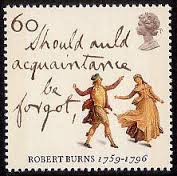 in an entry of the Scotch Presbyterian Eloquence, “It is ordinary among some plebeians in the South of Scotland to go about from door to door upon New-years Eve, crying Hagmane”. Wikipedia. The Hogmanay custom of singing “Auld Lang Syne” has become common in many countries. “Auld Lang Syne” is a traditional poem reinterpreted by Robert Burns.
in an entry of the Scotch Presbyterian Eloquence, “It is ordinary among some plebeians in the South of Scotland to go about from door to door upon New-years Eve, crying Hagmane”. Wikipedia. The Hogmanay custom of singing “Auld Lang Syne” has become common in many countries. “Auld Lang Syne” is a traditional poem reinterpreted by Robert Burns.
1232 Patrick I, Earl of Dunbar (5th Earl) died. Married to Ada Mac William (died 1200), or Scotland, daughter of Isabel Avenal (ca. 1143 – 1234), the daughter of Robert Avenal. Ada’s father was William the Lion (Mediaeval Gaelic Uilliam mac Eanric; Modern Gaelic: Uilleam mac Eanraig), sometimes styled William I, also known by the nickname Garbh, “the Rough”, (c 1143 – 4 December 1214) reigned as King of the Scots from 1165 to 1214. The Lion’s reign was the second longest in Scottish history before the Act of Union with England in 1707, (James VI’s was the longest 1567–1625). He became King following his brother Malcolm IV’s death on 9 December 1165 and was crowned on 24 December 1165
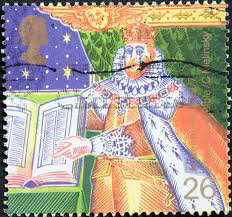 1384 John Wyclif, Reformer. Reforms make their way into the Scots religious beliefs nearly 2 centuries later.
1384 John Wyclif, Reformer. Reforms make their way into the Scots religious beliefs nearly 2 centuries later.
Translating the Bible.
1439 Margaret Holland, sister of 3rd Earl of Kent, died. The daughter of Thomas Holland, 2nd Earl of Kent, who was the son of Joan “the Fair Maid of Kent” (granddaughter of Edward 1st of England, wife of Edward the Black Prince and mother of Richard 2nd of England). Margaret’s mother was Alice FitzAlan, daughter of Richard FitzAlan, 10th Earl of Arundel and Eleanor of Lancaster. Margaret married John Beaufort, 1st Earl of Somerset, son of John of Gaunt, 1st Duke of Lancaster and his mistress Katherine Swynford. They had six children: Henry Beaufort, 2nd Earl of Somerset (c. 1401–25 November 1418). John Beaufort, 1st Duke of Somerset (baptized 25 March 1404–27 May 1444). Thomas Beaufort, Earl of Perche (c. 1405–1432).
Lady Joan Beaufort (c. 1406–15 July 1445), who married James 1st of Scotland and afterwards Sir James Stewart, the Black Knight of Lorn. These were ancestors of all Scots Royalty since 1430 and all English Royalty from 1603.
Edmund Beaufort, 2nd Duke of Somerset (c. 1406–22 May 1455).
Lady Margaret Beaufort, Countess of Devon (c. 1409–1449), married Thomas de Courtenay, 13th Earl of Devon.
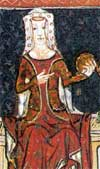 In 1399, Margaret was invested as a Lady Companion, Order of the Garter (L.G.). After Beaufort died in 1410 (in the Tower of London), she married his nephew Thomas of Lancaster, 1st Duke of Clarence, the son of King Henry 4th. They had no children.
In 1399, Margaret was invested as a Lady Companion, Order of the Garter (L.G.). After Beaufort died in 1410 (in the Tower of London), she married his nephew Thomas of Lancaster, 1st Duke of Clarence, the son of King Henry 4th. They had no children.
Joan of Kent, the fair Maid of Kent, Princess of Wales, Princess of Aquitaine. Countess of Salisbury, Countess of Kent, Baroness Wake of Liddell. Joan is often identified as the countess of Salisbury who, legend says, inspired Edward III’s founding of the Order of the Garter.
1448 Franco-Scottish alliance renewed at Tours.
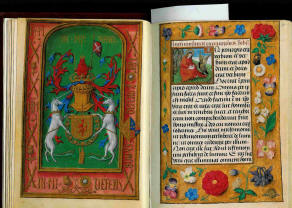 1503 sometime in, James 4th of Scotland portrait with Crown of Scotland in the Book of Hours created for his marriage to Margaret Tudor in 1503. This Book of Hours is the inspiration for this email Scots Book of Days.
1503 sometime in, James 4th of Scotland portrait with Crown of Scotland in the Book of Hours created for his marriage to Margaret Tudor in 1503. This Book of Hours is the inspiration for this email Scots Book of Days.
http://www.electricscotland.com/history/articles/wilkie.htm
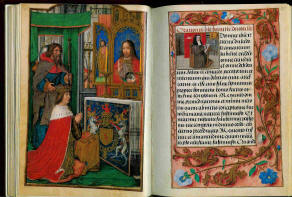 By 1707, the Book of Hours of James IV and Margaret Tudor, that magnificent object of the Scottish national heritage, already formed part of the Habsburg Court Library in Vienna, later incorporated into the Austrian National Library, where it remains to this day (2013) .
By 1707, the Book of Hours of James IV and Margaret Tudor, that magnificent object of the Scottish national heritage, already formed part of the Habsburg Court Library in Vienna, later incorporated into the Austrian National Library, where it remains to this day (2013) .
1544 John Blair and Patrick his son, abiding from the queen’s armies at Coldingham, Berwickshire, Scotland raid, in Pitcairn’s Criminal Trials, 4th year of Queen Mary. Anderson v. 1, p.319.
1548 Henry Stewart, 1st Lord Methven Master of Arltillery during siege of Haddington, Methven wrote to Mary of Guise on 31 December 1547 to discuss the use of artillery in the war. He said that Regent Arran had been advised that the modest (“sober”) Scottish artillery at St Andrews Castle at the start might have taken the castle, and the prolonged and expensive siege, after Arran had departed, had harmed public opinion. Similarly, a recent ineffective show of artillery at Broughty Castle had only warned the English to get more support and re-fortify. Now, to take Broughty, more cannon needed to be supplied, and Methven asked for French captains with intelligence of the field, and intelligence to assiege and order artillery.
1570 Auld Lang Syne” smetime in, is used in poems by Robert Ayton (1570–1638)
1599 year ends, as proclaimed by James VI. Next day [January 1] is the year 1600. Thus there were no days January 1st 1599 to March 24th 1599 in Scotland, but there were throughout the rest of Europe and England and British America, they just didn’t all occur the same time.
1686 “Auld Lang Syne” sometime in, is used in poems by Allan Ramsay (1686–1757) Wikipedia.
1604 The first day of Hogmanay or “Auld Year’s Night” (Scotland) a celebration which lasts through the night until the morning of New Year’s Day (1 January) or, in some cases, 2 January which is a Scottish Bank Holiday. The word is first recorded in 1604 in the Elgin Records as hagmonay) (delatit to haue been singand hagmonayis on Satirday).
1692 Hagmonay appears as an entry of the Scotch Presbyterian Eloquence. It is ordinary among some plebeians in the South of Scotland to go about from door to door upon New-years Eve, crying Hagmane
1692 Last day (expire) of Indemnity to insurgents, who had been in arms for James 7th Stewart, deposed King, who take oath of allegiance to the King [William] and Queen [Mary], from August proclamation. Barbarity disgraced the government of [King] William in Scotland, by a massacre of Macdonald of Glencoe, prevented from tendering his submission. Treachery and vengeance of Sir John Dalrymple, Earl of Stair, Secretary of State for Scotland, and Earl of Breadalbane. Tytler’s Britannica 219.
1711 sometime this year. Auld Lang Syne phrase published by James Watson. Wikipedia.
1720 – Charles Edward Stewart born in Rome, under the protection of Pope Clement XI., eldest son of Princess Clementina Sobieski and Chevalier de St. George. (TG75- 59) Prince Charles Edward styling himself Prince [TG75-61] of Wales, and Regent for James VIII (from 1744). (TG75-68) young adventurer. Charles Stuart and the rising of 1745, which aimed to restore the Stuart’s to the throne, form the backdrop for Walter Scott’s ‘Waverley”. Scott depicts Stuart’s personal qualities favorably, based on sources included in notes to “Waverley”:
‘That Charles Edward had the advantages of a graceful presence, courtesy, and an address and manner becoming his station, the author never heard disputed by any who approached his person, nor does he conceive that these qualities are overcharged in the present attempt to sketch his portrait.
The following extracts corroborative of the general opinion respecting the Prince’s amiable disposition are taken from a manuscript account of his romantic expedition, by James Maxwell of Kirkconnell, of which I possess a copy, by the friendship of J. Menzies, Esq., of Pitfoddells.  The author, though partial to the Prince, whom he faithfully followed, seems to have been a fair and candid man, and well acquainted with the intrigues among the adventurer’s council:–
The author, though partial to the Prince, whom he faithfully followed, seems to have been a fair and candid man, and well acquainted with the intrigues among the adventurer’s council:–
Menzies pronounced Min’gus. Motto: VIL GOD I SAL. Badge: menzie’s heath Chief: David R.S. Menzies of Menzies Crest: A savage head erased Proper
‘Everybody was mightily taken with the Prince’s figure and personal behaviour. There was but one voice about them. Those whom interest or prejudice made a runaway to his cause could not help acknowledging that they wished him well in all other respects, and could hardly blame him for his present undertaking.
1745 Perth. During the absence of Charles in England, Lord John Drummond arrived from France with money, military stores pecquets of 6 Irish regiments, Scots troops in the service of Louis XV. Lord Strathallan lay at Perth with Frasers, Mackintoshes, Mackenzies, and Farquharsons, and Lord Lewis Gordon, with Aberdeenshire men. The total was 4,000. Tytler’s Britannica 236.
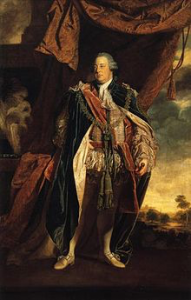 1745 the Duke of Cumberland (age 24) entered Carlisle on horseback, [TG81-258]. Son of George 2nd, and commander of regiment, with fictional enlistee Tom Jones of novel fame, by Henry Fielding, published by Andrew Miller VI, (1705-1768) London by the Strand.
1745 the Duke of Cumberland (age 24) entered Carlisle on horseback, [TG81-258]. Son of George 2nd, and commander of regiment, with fictional enlistee Tom Jones of novel fame, by Henry Fielding, published by Andrew Miller VI, (1705-1768) London by the Strand.
William Augustus, portrait by Sir Joshua Reynolds, 1758. (age 37) Wikipedia.
1775 Battle of Quebec. The 11th Earl and chief of Clan Montgomery raised the 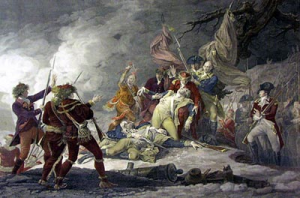 British 77th Foot Highlanders Regiment from members of the clan. Their exploits in the campaign against the French are legend, and it was this regiment, under General Forbes, which renamed modern Pittsburgh. General Richard Montgomery was killed in the storming of Quebec on December 31, 1775.
British 77th Foot Highlanders Regiment from members of the clan. Their exploits in the campaign against the French are legend, and it was this regiment, under General Forbes, which renamed modern Pittsburgh. General Richard Montgomery was killed in the storming of Quebec on December 31, 1775.
Death of General Montgomery during the attack on Quebec.
 Montgomery Motto: GARDE BIEN.
[from French: “Watch well”]. Chief: Archibald George Montgomerie, 18th Earl of Eglinton and 6th Earl of Winton. Crest: A lady dressed in ancient apparel Azure holding in her dexter hand an anchor and in her sinister hand the head of a savage couped suspended by the hair all Proper. Descendant of Hugh Montgomery (1460-1545) 1st Earl Eglinton, 3rd Baron Montgomerie, Laird of Ardrossan 1484, Justice General of Northern Scotland 1526, and Council of Regency 1536.
Montgomery Motto: GARDE BIEN.
[from French: “Watch well”]. Chief: Archibald George Montgomerie, 18th Earl of Eglinton and 6th Earl of Winton. Crest: A lady dressed in ancient apparel Azure holding in her dexter hand an anchor and in her sinister hand the head of a savage couped suspended by the hair all Proper. Descendant of Hugh Montgomery (1460-1545) 1st Earl Eglinton, 3rd Baron Montgomerie, Laird of Ardrossan 1484, Justice General of Northern Scotland 1526, and Council of Regency 1536.
1775 December 31. Battle of Quebec (1775). Captain McDougal led 120 of the 84th and 60 Royal Navy sailors against a force of New Hampshire troops commanded by Henry Dearborn. They overwhelmed Dearborn’s men, forcing the survivors to surrender. Lieutenant Duncan McDougall Senior,(clan Shaw and McDougall) was an officer in the 84th Foot Father in law of Ancestress of 4th great grand son John Christopher Stevens, Ambassador to Libya, assassinated in Benghazi Libya September 11, 2012. The 84th Regiment of Foot (Royal Highland Emigrants) was a British regiment in the American War of Independence that was raised to defend present day Ontario, Quebec and Atlantic Canada from the constant land and sea attacks by 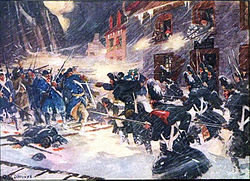 American Revolutionaries.The 84th Regiment was also involved in offensive action in the Thirteen Colonies; including North Carolina, South Carolina, Georgia, Virginia and what is now Maine, as well as raids upon Lake Champlain and the Mohawk Valley. The regiment consisted of 2,000 men in twenty companies. The 84th Regiment was raised from Scottish soldiers who had served in the Seven Years’ War and stayed in North America. As a result, the 84th Regiment had one of the oldest and most experienced officer corps of any regiment in North America. The Scottish Highland regiments were a key element of the British Army in the American Revolution. The 84th Regiment was clothed, armed and accoutred the same as the Black Watch. Canadian militiamen and British soldiers repulse the American assault at Sault-au-Matelot
American Revolutionaries.The 84th Regiment was also involved in offensive action in the Thirteen Colonies; including North Carolina, South Carolina, Georgia, Virginia and what is now Maine, as well as raids upon Lake Champlain and the Mohawk Valley. The regiment consisted of 2,000 men in twenty companies. The 84th Regiment was raised from Scottish soldiers who had served in the Seven Years’ War and stayed in North America. As a result, the 84th Regiment had one of the oldest and most experienced officer corps of any regiment in North America. The Scottish Highland regiments were a key element of the British Army in the American Revolution. The 84th Regiment was clothed, armed and accoutred the same as the Black Watch. Canadian militiamen and British soldiers repulse the American assault at Sault-au-Matelot
1796 Should auld acquintance be forgot, Robert Burns 1759-1796
Auld Lang Syne song featured in the movies usually at a party.
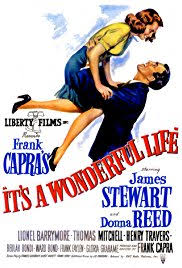 1946 – It’s a Wonderful Life (1946 Jimmy Stewart) at the end, Christmas Eve. Donna Reed, Lionel Barrymore, Thomas Mitchell,
1946 – It’s a Wonderful Life (1946 Jimmy Stewart) at the end, Christmas Eve. Donna Reed, Lionel Barrymore, Thomas Mitchell,
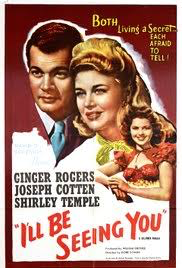 1944 – I’ll Be Seeing ye (1944 with Ginger Rogers).Ginger Rogers, Joseph Cotton, Shirley Temple
1944 – I’ll Be Seeing ye (1944 with Ginger Rogers).Ginger Rogers, Joseph Cotton, Shirley Temple
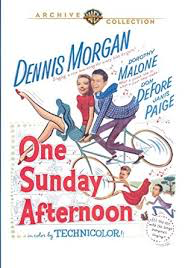 1949 One Sunday Afternoon – song sang on New Year’s eve, 10 minutes before end. One Sunday Afternoon Dennis Morgan, Don DeFore, Dorothy Malone,
1949 One Sunday Afternoon – song sang on New Year’s eve, 10 minutes before end. One Sunday Afternoon Dennis Morgan, Don DeFore, Dorothy Malone,
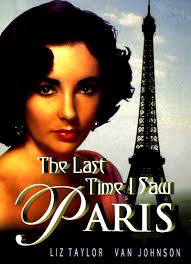 1954 The Last Time I Saw Paris (a new Year’s eve party – tragedy) Elizabeth Taylor poster. Eifel tower.
1954 The Last Time I Saw Paris (a new Year’s eve party – tragedy) Elizabeth Taylor poster. Eifel tower.
1989 -When Harry Met Sally (1989 Louis Armstrong)
The international Boy Scout youth jamborees.
The annual Edinburgh Military Tattoo.
Passing Out Parade of Young Officers in the Royal Navy at the Britannia Royal Naval College; and at the Commissioning Parade at the Royal Military Academy Sandhurst. for young officers joining the British Army. – to march, after the tune “Will ye no come back?”.
The Naval and Military colleges, especiallly the Commonwealth of Nations.
The Royal Military College of Canada, the Royal Military College (Malaysia), the National Defence Academy (India), the Indian Military Academy, the Officers Training Academy (India), the Pakistan Military Academy, and at the equivalent colleges in Singapore, Burma and Nigeria.
Wikipedia.
- Sung in these movies –
1939 The Light that Failed by Rudyard Kipling (a ship leaving port about 90 percent thru the movie)
1938 Letter of Introduction (George Murphy and Edgar Bergen New Year’s Eve party).
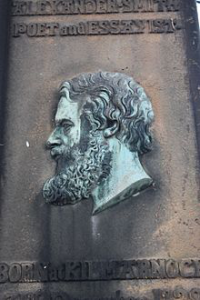 1830 – Alexander Smith, Scottish poet born in Kilmarnock, in the Scottish Lowlands south-west of Glasgow, (d. 1867)
1830 – Alexander Smith, Scottish poet born in Kilmarnock, in the Scottish Lowlands south-west of Glasgow, (d. 1867)
Alexander Smith’s grave, Warriston cemetery, Edinburgh. Wikipedia.
1864 George M. Dallas, (July 10, 1792 – December 31, 1864) was a U.S. Senator from Pennsylvania and the 11th Vice President of the United States (1845–1849), serving under James K. Polk. US Senator from Pennsylvania. Father Alexander Dallas educated in Edinburgh.
1878 After Dec. 31, 1878, the name of Glasgow Conference of the Church of Jesus Christ was seldom used. On that date the Scottish Conference contained 14 branches and had a total membership of 525, including 4 High Priests, 5 Seventies, 69 Elders, 20 Priests, 35 Teachers and 14 Deacons; 131 persons had emigrated to Utah during the year. From that time the Scottish Conference has had a continued existence. The headquarters of the district in 1930 were maintained in Glasgow. Of ninety inhabitants of Hunterfield, a mining town near Edinburgh, seventy belonged to the branch.
1907 sometime this year. Auld Lang Syne Number two on the music sales chart.
1915 sometime in December -The 6th Indian Division, of which the 62nd Punjabis were a part, was landed at Basra on 31 December 1915 for the Mesopotamian campaign. In July 1916, World War II Field Marshal Sir Claude Auchinleck GCB, GCIE, CSI, DSO, OBE (21 June 1884 – 23 March 1981), nicknamed “The Auk”, British army commander during World War II, was promoted Acting Major and made second in command of the regiment. The Auchinlecks were an Ulster-Scots family from County Fermanagh, where they had settled in the 17th century.
1915 Macbeth (1915 film), French language film starring Séverin-Mars and Georgette Leblanc
1921 sometime this year. Auld Lang Syne Number five on the music sales chart.
1929 Glen Cinema Disaster, Paisley, Scotland, (31 December 1929). Glen Cinema Website
1929 New York’s Roosevelt Hotel, Grill Room. Guy Lombardo and His Royal Canadians began the tradition of playing ‘Auld Lang Syne’ on New Year’s Eve. The tradition continued through four decades, and became the theme song of New Year’s eve around the world. Lombardo died in 1977 at age 75.
1977 Beth Clare Sorensen (nee Choate) born, (many great grand daughter of Margaret Holland). (clans Baliol 1240 DNB 1: 981/1014-990, Barclay of Gairntilly 1162 DNB 1:1076/1109, Barde 1338 DNB 1:1095, Beauford 1430, Blair of Blair, Borthwick Midlothian, Boswell of Auchinleck, and Balmuto, Boyd of Kilmarnock 1470, Boyd of Boyd 1450 Boidh 1200, Brus or Bruce King of Scots 1329 Annandale Earl of Carrick, Burgh 1263, Bute 1218, Buttergask 1520)
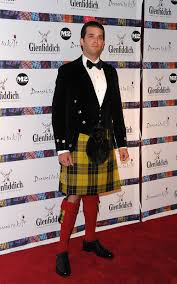 1977 Donald John Trump Junior born Manhattan, New York. Son of Donald Trump Senior (clans MacLeod, MCSwane, Smith). Mother is Ivana Trump.
1977 Donald John Trump Junior born Manhattan, New York. Son of Donald Trump Senior (clans MacLeod, MCSwane, Smith). Mother is Ivana Trump.
| University of Pennsylvania (B.S.) |
December
Disclaimer: The author of each article published on this web site owns his or her own words. The opinions, beliefs and viewpoints expressed by the various authors and forum participants on this site do not necessarily reflect the opinions, beliefs and viewpoints of Utah Standard News or official policies of the USN and may actually reflect positions that USN actively opposes. No claim in public domain or fair use. © John Choate
Utah Standard News depends on the support of readers like you.
Good Journalism requires time, expertise, passion and money. We know you appreciate the coverage here. Please help us to continue as an alternative news website by becoming a subscriber or making a donation. To learn more about our subscription options or make a donation, click here.
To Advertise on UtahStandardNews.com, please contact us at: ed@utahstandardnews.com.


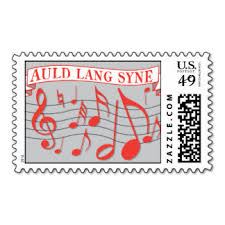
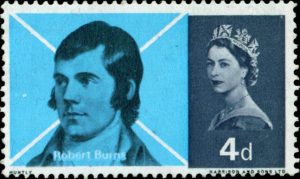
Comments - No Responses to “December 31st Scots Book of Days. Hogmanay.”
Sure is empty down here...